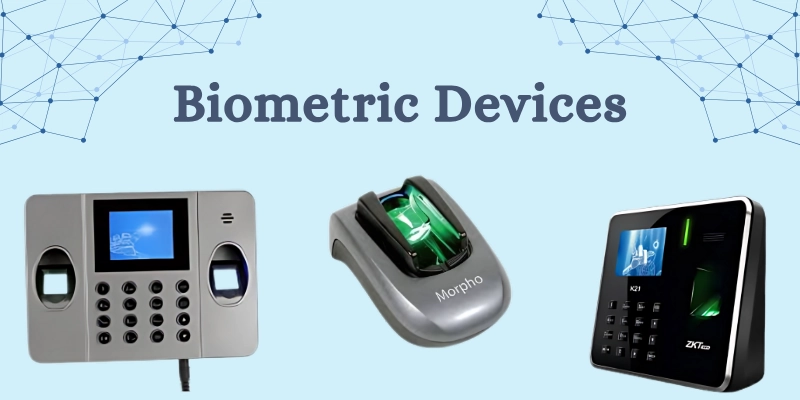Biometric Devices That Keep Hackers and Threats Away
Published: 3 Oct 2025
How biometric devices are changing security and identification in our daily lives is remarkable. From offices and airports to smartphones and banks, these devices make access safer and more convenient.
This article explains biometric devices, their types, uses, advantages, limitations, and future trends.

You will also learn about biometric technology, including fingerprint scanners, facial recognition devices, and iris scanners.
What are Biometric Devices?
Biometric devices are specialized tools that identify and verify individuals using unique physical or behavioral traits. These traits can include fingerprints, facial features, iris patterns, voice, or even the way someone types or walks. Biometric devices are input devices.
How do they work?
A biometric system captures a person’s unique trait and converts it into digital data. This data is then compared with stored templates to confirm identity. This process, known as biometric identification, is fast, accurate, and difficult to fake.
Biometric devices are widely used in offices, airports, banks, smartphones, and secure facilities to control access, track attendance, or verify identities.
History of Biometric Technology
The history of biometric devices shows how identification methods evolved from manual fingerprints and iris patterns to digital systems. The evolution of biometric technology and ongoing biometric technology development have made modern security faster, safer, and more reliable.
- Early Identification: Fingerprints and iris patterns were used manually to recognize individuals.
- Manual Records: Early biometric methods relied on physical documentation and human verification.
- Digital Evolution: Biometric systems became automated with scanners, software, and databases.
- Accuracy Improvement: Digital technology reduced errors and increased reliability in identification.
- Widespread Adoption: Used in offices, airports, banks, and law enforcement for secure access.
- Modern Devices: Includes fingerprint scanners, facial recognition devices, and iris scanners.
- Biometric Technology Development: Continuous advancements improve speed, security, and convenience.
Types of Biometric Devices
Biometric devices use unique physical or behavioral traits to identify and verify individuals. They provide faster, safer, and more reliable security in everyday life.
Here are some types of biometric devices.
- Fingerprint Scanner:
A fingerprint biometric device captures unique fingerprint patterns to identify individuals. It is widely used in smartphones, offices, and security doors. - Facial Recognition Device:
A facial recognition biometric device uses facial patterns to verify identity. Common applications include airports, smartphones, and attendance systems. - Iris Scanner:
An iris biometric device scans the unique patterns in the eye for authentication. Known for very high accuracy, it is used in airports and high-security areas. - Voice Recognition Device:
A voice biometric device identifies individuals based on voice patterns. It is frequently used in call centers and on smartphones. - Hand Geometry Scanner:
A hand geometry scanner measures the shape and size of the hand for identification. It is used in offices and restricted access areas. - Signature Verification Device:
A signature biometric device recognizes the unique way a person signs. Commonly used in banking and official document verification.
Uses of Biometric Devices
Biometric devices have become essential in daily life, offering secure, accurate, and efficient ways to identify individuals. Their applications of biometric technology span multiple sectors.
- Security Systems: Control access for offices, homes, and airports using biometric devices.
- Time and Attendance: Track employee attendance accurately and prevent fraud.
- Banking and Finance: Enable secure transactions, ATM access, and identity verification.
- Healthcare: Identify patients and manage medical records safely.
- Government Services: Verify national ID cards, passports, and other official documents.
Pros and Cons of Biometric Devices
Understanding the advantages and disadvantages of biometric devices helps evaluate their effectiveness in security and identification.
Exploring the benefits and limitations of biometric technology shows how it improves convenience while highlighting potential challenges.
| Advantages | Disadvantages |
| High security, hard to forge or steal | Privacy concerns, sensitive personal data collected |
| Fast and convenient identification | Expensive to install and maintain |
| Accurate verification reduces errors | Some devices may fail due to injuries or changes in traits |
| Reduces the need for passwords or ID cards | Risk of system hacking if data is stored insecurely |
| Widely applicable, offices, banks, airports | Not always suitable in all environments (e.g., dirty hands, poor lighting) |
Biometric Devices in Different Sectors
Biometric devices in different sectors enhance security, efficiency, and accuracy. Their applications span business, government, healthcare, and transportation.
- Banking & Finance: Secure transactions, ATM access, and fraud prevention (biometric devices in business).
- Government: Passport verification, national ID cards, and other official document authentication (biometric devices in government).
- Healthcare: Patient authentication, medical record management, and hospital access (biometric devices in healthcare).
- Airports & Transportation: Fast passenger check-in, boarding, and security clearance.
- Corporate Offices: Employee access control and attendance tracking.
Future of Biometric Devices
The future of biometric devices looks promising, with advanced technology improving security and convenience. Emerging biometric technology trends are shaping the next generation of identification systems.
- AI Integration: Enhances accuracy and speed in identification.
- Multi-Factor Biometric Authentication: Combines traits for stronger security.
- Mobile & Wearable Devices: Biometric systems are becoming portable and more accessible.
- Global Adoption: Increasing use for secure digital identification worldwide.
- Next-Generation Biometric Devices: Smarter, faster, and more reliable systems for everyday life.
Conclusion
Biometric devices are tools that identify individuals using unique physical or behavioral traits. From fingerprint scanners to iris scanners, their types, uses, advantages, and limitations show how versatile and reliable these systems are.
The importance of biometric devices lies in providing fast, accurate, and secure identification. The role of biometric technology in modern security continues to grow, making these devices essential for protecting data, managing access, and verifying identities in today’s world.
Take control of your security, learn how biometric devices can safeguard your life!
FAQs
Want to know more? Check our FAQs on biometric devices now!
Biometric devices are tools that identify people using unique traits like fingerprints, faces, or voices. They provide secure and reliable ways to verify identity.
You can check biometric devices by testing their accuracy, speed, and ease of use. Make sure they properly scan fingerprints, faces, or other traits without errors.
A device is biometric if it uses unique physical or behavioral traits, like fingerprints, facial patterns, or voice, for identification and security.
Yes, many biometric devices can connect to mobiles through apps, Bluetooth, or USB. Smartphones also have built-in biometric features like fingerprint and face scanners.
No, biometric devices don’t always need the internet to work. They can store and verify data offline, but some systems use the internet for syncing or remote access.
To activate a biometric device, install its software or app, connect it to your system, and register user data like fingerprints or face. Then, enable it in the settings.

- Be Respectful
- Stay Relevant
- Stay Positive
- True Feedback
- Encourage Discussion
- Avoid Spamming
- No Fake News
- Don't Copy-Paste
- No Personal Attacks

- Be Respectful
- Stay Relevant
- Stay Positive
- True Feedback
- Encourage Discussion
- Avoid Spamming
- No Fake News
- Don't Copy-Paste
- No Personal Attacks





